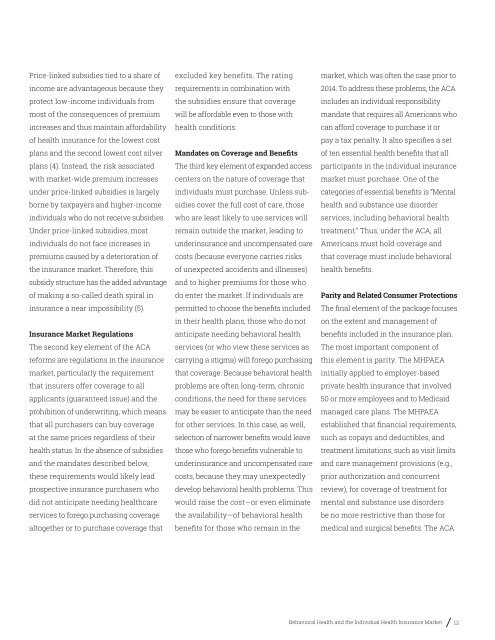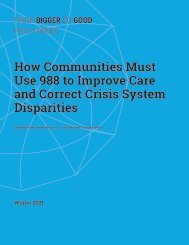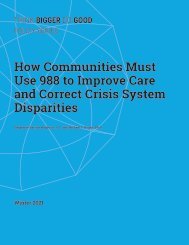Behavioral Health and the Individual Health Insurance Market
Create successful ePaper yourself
Turn your PDF publications into a flip-book with our unique Google optimized e-Paper software.
Price-linked subsidies tied to a share of<br />
income are advantageous because <strong>the</strong>y<br />
protect low-income individuals from<br />
most of <strong>the</strong> consequences of premium<br />
increases <strong>and</strong> thus maintain affordability<br />
of health insurance for <strong>the</strong> lowest cost<br />
plans <strong>and</strong> <strong>the</strong> second lowest cost silver<br />
plans (4). Instead, <strong>the</strong> risk associated<br />
with market-wide premium increases<br />
under price-linked subsidies is largely<br />
borne by taxpayers <strong>and</strong> higher-income<br />
individuals who do not receive subsidies.<br />
Under price-linked subsidies, most<br />
individuals do not face increases in<br />
premiums caused by a deterioration of<br />
<strong>the</strong> insurance market. Therefore, this<br />
subsidy structure has <strong>the</strong> added advantage<br />
of making a so-called death spiral in<br />
insurance a near impossibility (5).<br />
<strong>Insurance</strong> <strong>Market</strong> Regulations<br />
The second key element of <strong>the</strong> ACA<br />
reforms are regulations in <strong>the</strong> insurance<br />
market, particularly <strong>the</strong> requirement<br />
that insurers offer coverage to all<br />
applicants (guaranteed issue) <strong>and</strong> <strong>the</strong><br />
prohibition of underwriting, which means<br />
that all purchasers can buy coverage<br />
at <strong>the</strong> same prices regardless of <strong>the</strong>ir<br />
health status. In <strong>the</strong> absence of subsidies<br />
<strong>and</strong> <strong>the</strong> m<strong>and</strong>ates described below,<br />
<strong>the</strong>se requirements would likely lead<br />
prospective insurance purchasers who<br />
did not anticipate needing healthcare<br />
services to forego purchasing coverage<br />
altoge<strong>the</strong>r or to purchase coverage that<br />
excluded key benefits. The rating<br />
requirements in combination with<br />
<strong>the</strong> subsidies ensure that coverage<br />
will be affordable even to those with<br />
health conditions.<br />
M<strong>and</strong>ates on Coverage <strong>and</strong> Benefits<br />
The third key element of exp<strong>and</strong>ed access<br />
centers on <strong>the</strong> nature of coverage that<br />
individuals must purchase. Unless subsidies<br />
cover <strong>the</strong> full cost of care, those<br />
who are least likely to use services will<br />
remain outside <strong>the</strong> market, leading to<br />
underinsurance <strong>and</strong> uncompensated care<br />
costs (because everyone carries risks<br />
of unexpected accidents <strong>and</strong> illnesses)<br />
<strong>and</strong> to higher premiums for those who<br />
do enter <strong>the</strong> market. If individuals are<br />
permitted to choose <strong>the</strong> benefits included<br />
in <strong>the</strong>ir health plans, those who do not<br />
anticipate needing behavioral health<br />
services (or who view <strong>the</strong>se services as<br />
carrying a stigma) will forego purchasing<br />
that coverage. Because behavioral health<br />
problems are often long-term, chronic<br />
conditions, <strong>the</strong> need for <strong>the</strong>se services<br />
may be easier to anticipate than <strong>the</strong> need<br />
for o<strong>the</strong>r services. In this case, as well,<br />
selection of narrower benefits would leave<br />
those who forego benefits vulnerable to<br />
underinsurance <strong>and</strong> uncompensated care<br />
costs, because <strong>the</strong>y may unexpectedly<br />
develop behavioral health problems. This<br />
would raise <strong>the</strong> cost—or even eliminate<br />
<strong>the</strong> availability—of behavioral health<br />
benefits for those who remain in <strong>the</strong><br />
market, which was often <strong>the</strong> case prior to<br />
2014. To address <strong>the</strong>se problems, <strong>the</strong> ACA<br />
includes an individual responsibility<br />
m<strong>and</strong>ate that requires all Americans who<br />
can afford coverage to purchase it or<br />
pay a tax penalty. It also specifies a set<br />
of ten essential health benefits that all<br />
participants in <strong>the</strong> individual insurance<br />
market must purchase. One of <strong>the</strong><br />
categories of essential benefits is “Mental<br />
health <strong>and</strong> substance use disorder<br />
services, including behavioral health<br />
treatment.” Thus, under <strong>the</strong> ACA, all<br />
Americans must hold coverage <strong>and</strong><br />
that coverage must include behavioral<br />
health benefits.<br />
Parity <strong>and</strong> Related Consumer Protections<br />
The final element of <strong>the</strong> package focuses<br />
on <strong>the</strong> extent <strong>and</strong> management of<br />
benefits included in <strong>the</strong> insurance plan.<br />
The most important component of<br />
this element is parity. The MHPAEA<br />
initially applied to employer-based<br />
private health insurance that involved<br />
50 or more employees <strong>and</strong> to Medicaid<br />
managed care plans. The MHPAEA<br />
established that financial requirements,<br />
such as copays <strong>and</strong> deductibles, <strong>and</strong><br />
treatment limitations, such as visit limits<br />
<strong>and</strong> care management provisions (e.g.,<br />
prior authorization <strong>and</strong> concurrent<br />
review), for coverage of treatment for<br />
mental <strong>and</strong> substance use disorders<br />
be no more restrictive than those for<br />
medical <strong>and</strong> surgical benefits. The ACA<br />
<strong>Behavioral</strong> <strong>Health</strong> <strong>and</strong> <strong>the</strong> <strong>Individual</strong> <strong>Health</strong> <strong>Insurance</strong> <strong>Market</strong> 12

















